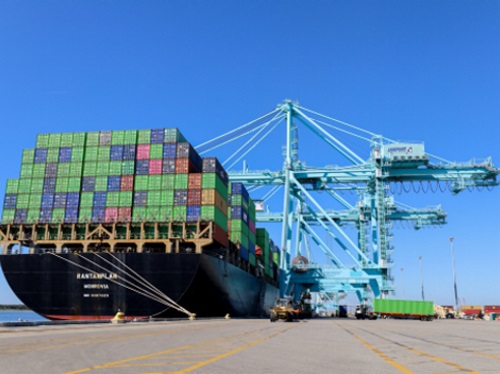The U.S. Maritime Administration – known as MARAD – recently disbursed more than $703 million to fund 41 projects in 22 states and one U.S. territory via its Port Infrastructure Development Program or PIDP.
[Above photo by the Jacksonville Port Authority]
That funding aims to boost port capacity and resilience, make freight operations more efficient, reduce port emissions, and generate new workforce opportunities, the agency said.
MARAD noted this round of PIDP funding received a boost from the $1.2 trillion Infrastructure Investment and Jobs Act enacted in November 2021 as well as additional Congressional appropriations. Funding recipients include coastal seaports, Great Lakes ports, and inland river ports, the agency noted.

“Investment in all segments of our port infrastructure [enables] us to move goods more quickly, strengthen supply chain resiliency, and reduce the climate impacts of port operations themselves,” said MARAD Administrator Ann Phillips in a statement.
MARAD noted its PIDP supports efforts by ports and industry stakeholders to improve port and related freight infrastructure to meet the nation’s current freight transportation needs while ensuring port infrastructure can meet anticipated growth in freight volumes.
The program provides planning, capital funding, and project management assistance to improve port capacity and efficiency in both urban and rural areas for planning and capital projects. It also includes a statutory set-aside for small ports to continue to improve and expand their capacity to move freight reliably and efficiently and support local and regional economies.
Those freight capacity investments are a reflection of major supply chain issues affecting both the U.S. and global economy.

For example, the 2022 “State of Logistics” report – unveiled in June during a press event in Washington, D.C. – indicates that the cost of storing, handling, and financing business inventories is rising steeply in the United States, with “residual challenges” from the COIVID-19 pandemic continuing to “disrupt and damage” supply chain capacity.
That yearly report – compiled by consulting firm Kearney, the Council of Supply Chain Management Professionals, and logistics service provider Penske Logistics – details all the costs associated with moving freight through the U.S. supply chain. It also provides an analysis of the state of the U.S. economy and key logistics trends as well.
Overall, the 2022 report described the U.S. logistics system as “out of sync” in 2021, with “severe mismatches” between demand and supply in everything from labor to transportation and warehousing capacity to supply for raw materials and supplies.

The report found that U.S. inventory-carrying costs increased by 25.9 percent in 2021, with transportation costs jumping 21.7 percent – creating “uneven” supply chain operations and “inconsistent product availability” for consumers shopping both in-person and online.
“It seems clear that the macro-economy in 2022, which once promised to bring strong continued recovery from the pandemic, will instead be characterized by war [currently between Ukraine and Russia] and even greater uncertainty,” the report said.
“The long-term repercussions, though still largely unknown, could soon trigger a whole new level of disruption,” it added.
MARAD also noted that this latest round of PIDP awards also focused on social justice, emissions-reduction, and clean energy development efforts at U.S. ports.
The agency said that more than 60 percent of the awards from this round of funding would benefit ports in historically disadvantaged communities, with several of those projects seeking to reduce port emissions via electrification endeavors. Additionally, more than $150 million in awards include a focus on electrification of port equipment to reduce emissions and improve air quality.
MARAD added that this round of awards also includes nearly $100 million for port projects that will advance offshore wind deployment in support of the Biden administration’s bold goal of deploying 30 gigawatts of offshore wind by 2030.



